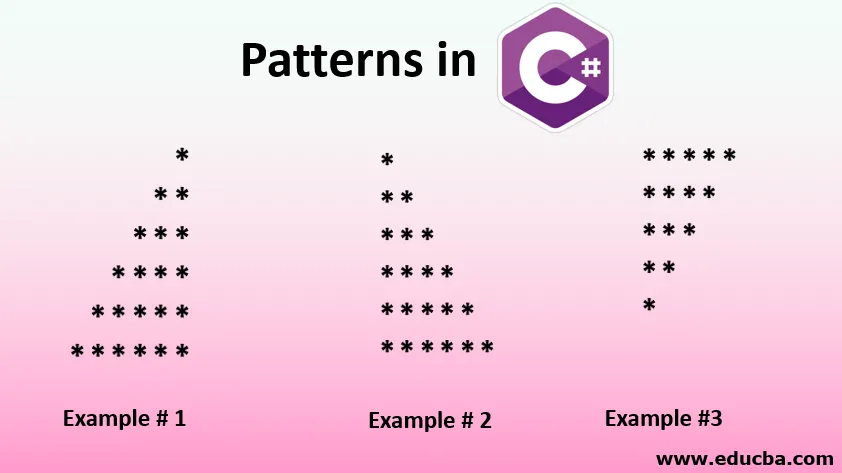
Introdução aos padrões em C #
Os padrões são o design decorativo repetido. Existe um código simples para escrever padrões em C #. Podemos escrever código para imprimir diferentes tipos de padrões, como padrão de estrela, padrão de caractere e padrão numérico. Abaixo estão os vários exemplos para imprimir padrões de estrelas, caracteres e valores numéricos. Esses exemplos consistem em loops ou loops aninhados, que são um loop interno para um loop. Os padrões são uma maneira de projetar em sequência ou de maneira lógica. Podemos imprimir triângulos, pirâmides, diamantes e outras simetrias.
Os três principais tipos de padrões em C #
Os três principais tipos de padrões em c # são mencionados abaixo.
1. Padrão de estrela
A seguir, exemplos para imprimir padrões de estrelas.
Exemplo 1
using System;
using System.Collections.Generic;
using System.Linq;
using System.Text;
namespace StarPattern
(
class Program
(
static void Main(string() args)
(
int x, y, z;
for (x =6; x >= 1; x--)
(
for (y = 1; y < x; y++)
(
Console.Write(" ");
)
for (z = 6; z >= x; z--)
(
Console.Write("*");
)
Console.WriteLine();
)
Console.ReadLine();
)
)
)
Resultado:

Exemplo 2
using System;
using System.Collections.Generic;
using System.Linq;
using System.Text;
namespace StarPattern
(
class Program
(
static void Main(string() args)
(
int x, y;
for (x = 1; x <= 6; x++)
(
for (y = 1; y <= x; y++)
(
Console.Write("*");
)
Console.WriteLine();
)
Console.ReadLine();
)
)
)
Resultado:

Exemplo 3
using System;
using System.Collections.Generic;
using System.Linq;
using System.Text;
namespace StarPattern
(
class Program
(
static void Main(string() args)
(
int x, y;
for (x = 5; x >= 1; x--)
(
for (y = 1; y <= x; y++)
(
Console.Write("*");
)
Console.WriteLine();
)
Console.ReadLine();
)
)
)
Resultado:
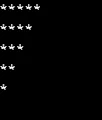
Exemplo 4
using System;
using System.Collections.Generic;
using System.Linq;
using System.Text;
namespace StarPattern
(
class Program
(
static void Main(string() args)
(
int x, y, z;
for (x = 5; x >= 1; x--)
(
for (y = 5; y > x; y--)
(
Console.Write(" ");
)
for (z = 1; z <=x; z++)
(
Console.Write("*");
)
Console.WriteLine();
)
Console.ReadLine();
)
)
)
Resultado:
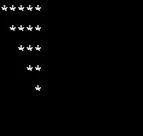
Exemplo 5
using System;
using System.Collections.Generic;
using System.Linq;
using System.Text;
namespace StarPattern
(
class Program
(
static void Main(string() args)
(
int x, y, z;
for (x= 1; x <= 5; x++)
(
for (y = x; y < 5; y++)
(
Console.Write(" ");
)
for (z = 1; z < (x * 2); z++)
(
Console.Write("*");
)
Console.WriteLine();
)
Console.ReadLine();
)
)
)
Resultado:

Exemplo 6
using System;
using System.Collections.Generic;
using System.Linq;
using System.Text;
namespace StarPattern
(
class Program
(
static void Main(string() args)
(
int x, y, z;
for (x = 5; x >= 1; x--)
(
for (y = 5; y > x; y--)
(
Console.Write(" ");
)
for (z = 1; z < (x * 2); z++)
(
Console.Write("*");
)
Console.WriteLine();
)
Console.ReadLine();
)
)
)
Resultado:
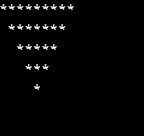
Exemplo 7
using System;
using System.Collections.Generic;
using System.Linq;
using System.Text;
namespace StarPattern
(
class Program
(
static void Main(string() args)
(
int x, y;
for (x = 1; x <= 5; x++)
(
for (y = x; y < 5; y++)
(
Console.Write(" ");
)
for (y = 1; y <= (2 * x - 1); y++)
(
if (x == 5 || y == 1 || y == (2 * x - 1))
(
Console.Write("*");
)
else
(
Console.Write(" ");
)
)
Console.WriteLine();
)
Console.ReadLine();
)
)
)
Resultado:
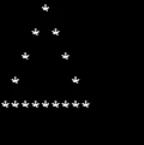
Exemplo 8
using System;
using System.Collections.Generic;
using System.Linq;
using System.Text;
namespace CharacterPattern
(
class Program
(
static void Main(string() args)
(
int x, y;
for (x = 1; x <= 5; x++)
(
for (y = 1; y <= 5; y++)
(
Console.Write("*");
)
Console.WriteLine();
)
Console.ReadLine();
)
)
)
Resultado:
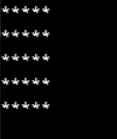
Exemplo # 9
using System;
using System.Collections.Generic;
using System.Linq;
using System.Text;
namespace CharacterPattern
(
class Program
(
static void Main(string() args)
(
int x, y;
for (x = 1; x <= 5; x++)
(
for (y = 1; y <= x; y++)
(
if (y == 1 || y== x || x == 5)
(
Console.Write("*");
)
else
(
Console.Write(" ");
)
)
Console.WriteLine();
)
Console.ReadLine();
)
)
)
Resultado:
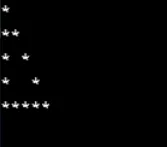
2. Padrões Numéricos
A seguir, exemplos para imprimir padrões numéricos.
Exemplo 1
using System;
using System.Collections.Generic;
using System.Linq;
using System.Text;
namespace NumberPattern
(
class Program
(
static void Main(string() args)
(
int x, y;
for (x = 1; x <= 5; x++)
(
for (y = 1; y <= x; y++)
(
Console.Write(y);
)
Console.WriteLine();
)
Console.ReadLine();
)
)
)
Resultado:

Exemplo 2
using System;
using System.Collections.Generic;
using System.Linq;
using System.Text;
namespace NumberPattern
(
class Program
(
static void Main(string() args)
(
int x, y;
for (x = 5; x >= 1; x--)
(
for (y = 1; y <= x; y++)
(
Console.Write(y);
)
Console.WriteLine();
)
Console.ReadLine();
)
)
)
Resultado:
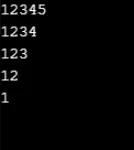
Exemplo 3
using System;
using System.Collections.Generic;
using System.Linq;
using System.Text;
namespace NumberPattern
(
class Program
(
static void Main(string() args)
(
int x, y;
for (x = 5; x >= 1; x--)
(
for (y = x; y <= 5; y++)
(
Console.Write(y);
)
Console.WriteLine();
)
Console.ReadLine();
)
)
)
Resultado:
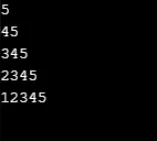
Exemplo 4
using System;
using System.Collections.Generic;
using System.Linq;
using System.Text;
namespace NumberPattern
(
class Program
(
static void Main(string() args)
(
int x, y;
for (x = 1; x <= 5; x++)
(
for (y = x; y <= 5; y++)
(
Console.Write(y);
)
Console.WriteLine();
)
Console.ReadLine();
)
)
)
Resultado:

Exemplo 5
using System;
using System.Collections.Generic;
using System.Linq;
using System.Text;
using System.Threading.Tasks;
namespace NumberPattern
(
class Program
(
static void Main(string() args)
(
int x, y;
for (x = 1; x <= 5; x++)
(
for (y = 1; y <= x; y++)
(
Console.Write(x);
)
Console.WriteLine();
)
Console.ReadLine();
)
)
)
Resultado:

Exemplo 6
using System;
using System.Collections.Generic;
using System.Linq;
using System.Text;
using System.Threading.Tasks;
namespace NumberPattern
(
class Program
(
static void Main(string() args)
(
int x, y;
for (x = 5; x >= 1; x--)
(
for (y = 5; y >= x; y--)
(
Console.Write(x);
)
Console.WriteLine();
)
Console.ReadLine();
)
)
)
Resultado:
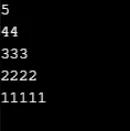
Exemplo 7
using System;
using System.Collections.Generic;
using System.Linq;
using System.Text;
using System.Threading.Tasks;
namespace NumberPattern
(
class Program
(
static void Main(string() args)
(
int x, y;
for (x = 5; x >= 1; x--)
(
for (y = 1; y <= x; y++)
(
Console.Write(x);
)
Console.WriteLine();
)
Console.ReadLine();
)
)
)
Resultado:
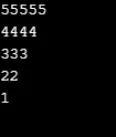
Exemplo 8
using System;
using System.Collections.Generic;
using System.Linq;
using System.Text;
using System.Threading.Tasks;
namespace NumberPattern
(
class Program
(
static void Main(string() args)
(
int x, y;
for (x = 1; x <= 5; x++)
(
for (y = 5; y >= x; y--)
(
Console.Write(x);
)
Console.WriteLine();
)
Console.ReadLine();
)
)
)
Resultado:
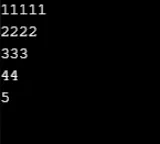
Exemplo # 9
using System;
using System.Collections.Generic;
using System.Linq;
using System.Text;
using System.Threading.Tasks;
namespace NumberPattern
(
class Program
(
static void Main(string() args)
(
int x, y;
for (x = 6; x >= 1; x--)
(
for (y = x; y >= 1; y--)
(
Console.Write(y);
)
Console.WriteLine();
)
Console.ReadLine();
)
)
)
Resultado:
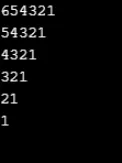
Exemplo # 10
using System;
using System.Collections.Generic;
using System.Linq;
using System.Text;
using System.Threading.Tasks;
namespace NumberPattern
(
class Program
(
static void Main(string() args)
(
int x, y;
for (x = 1; x <= 5; x++)
(
for (y = 6; y >= x; y--)
(
Console.Write(y);
)
Console.WriteLine();
)
Console.ReadLine();
)
)
)
Resultado:
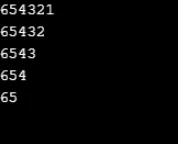
Exemplo # 11
using System;
using System.Collections.Generic;
using System.Linq;
using System.Text;
using System.Threading.Tasks;
namespace NumberPattern
(
class Program
(
static void Main(string() args)
(
int x, y;
for (x = 7; x >= 1; x -= 2)
(
for (y = 1; y <= x; y++)
(
Console.Write(y);
)
Console.WriteLine();
)
Console.ReadLine();
)
)
)
Resultado:
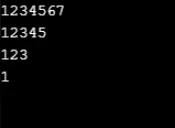
3. Padrão de Caractere
o A seguir, são apresentados exemplos para imprimir padrões de caracteres.
Exemplo 1
using System;
using System.Collections.Generic;
using System.Linq;
using System.Text;
namespace CharacterPattern
(
class Program
(
static void Main(string() args)
(
int x, y;
int z = 5;
for (x = 1; x <= z; x++)
(
for (y = 1; y <= x; y++)
(
Console.Write((char)(x + 64));
)
Console.WriteLine("");
)
Console.ReadLine();
)
)
)
Resultado:
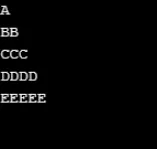
Exemplo 2
using System;
using System.Collections.Generic;
using System.Linq;
using System.Text;
namespace CharacterPattern
(
class Program
(
static void Main(string() args)
(
int x, y;
int z = 5;
for (x = 1; x <= z; x++)
(
for (y = x; y <= z; y++)
(
Console.Write((char)(x + 64));
)
Console.WriteLine("");
)
Console.ReadLine();
)
)
)
Resultado:
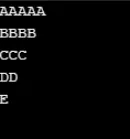
Exemplo 3
using System;
using System.Collections.Generic;
using System.Linq;
using System.Text;
namespace CharacterPattern
(
class Program
(
static void Main(string() args)
(
int x, y;
int z = 5;
for (x = 1; x <= z; x++)
(
for (y = 1; y <= x; y++)
(
Console.Write((char)(z - x + 1 + 64));
)
Console.WriteLine("");
)
Console.ReadLine();
)
)
)
Resultado:
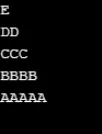
Exemplo 4
using System;
using System.Collections.Generic;
using System.Linq;
using System.Text;
namespace CharacterPattern
(
class Program
(
static void Main(string() args)
(
int x, y;
int z = 5;
for (x = 1; x <= z; x++)
(
for (y = x; y<= z; y++)
(
Console.Write((char)(y + 64));
)
Console.WriteLine();
)
Console.ReadLine();
)
)
)
Resultado:
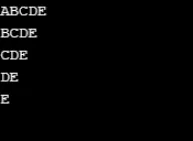
Exemplo 5
using System;
using System.Collections.Generic;
using System.Linq;
using System.Text;
namespace CharacterPattern
(
class Program
(
static void Main(string() args)
(
int x, y, z;
int k = 5;
for (x = 1; x <= k; x++)
(
for (y = 1; y <= k - x; y++)
(
Console.Write(" ");
)
for (z = 1; z <= x; z++)
(
Console.Write((char)(x + 64));
)
Console.WriteLine();
)
Console.ReadLine();
)
)
)
Resultado:
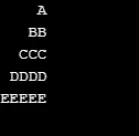
Exemplo 6
using System;
using System.Collections.Generic;
using System.Linq;
using System.Text;
namespace CharacterPattern
(
class Program
(
static void Main(string() args)
(
int x, y;
int a = 5;
for (x = 1; x <= a; x++)
(
for (y = x; y >= 1; y--)
(
Console.Write((char)(y + 64));
)
Console.WriteLine("");
)
Console.ReadLine();
)
)
)
Resultado:
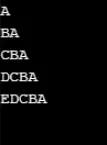
Exemplo 7
using System;
using System.Collections.Generic;
using System.Linq;
using System.Text;
namespace CharacterPattern
(
class Program
(
static void Main(string() args)
(
int x, y;
int a = 5;
for (x = a; x >= 1; x--)
(
for (y = a; y >= x; y--)
(
Console.Write((char)(y + 64));
)
Console.WriteLine("");
)
Console.ReadLine();
)
)
)
Resultado:
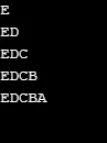
Exemplo 8
using System;
using System.Collections.Generic;
using System.Linq;
using System.Text;
namespace CharacterPattern
(
class Program
(
static void Main(string() args)
(
int x, y;
int a = 5;
for (x = 1; x <= a; x++)
(
for (y = a; y >= x; y--)
(
Console.Write((char)(y + 64));
)
Console.WriteLine("");
)
Console.ReadLine();
)
)
)
Resultado:
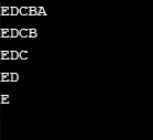
Exemplo # 9
using System;
using System.Collections.Generic;
using System.Linq;
using System.Text;
namespace CharacterPattern
(
class Program
(
static void Main(string() args)
(
int x, y;
int z = 5;
for (x = z; x >= 1; x--)
(
for (y = x; y >= 1; y--)
(
Console.Write((char)(y + 64));
)
Console.WriteLine("");
)
Console.ReadLine();
)
)
)
Resultado:
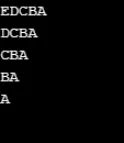
Exemplo # 10
using System;
using System.Collections.Generic;
using System.Linq;
using System.Text;
namespace CharacterPattern
(
class Program
(
static void Main(string() args)
(
int x, y;
int z = 6;
for (x = 1; x <= z; x++)
(
for (y = 1; y<= z - x; y++)
(
Console.Write(" ");
)
for (y = 1; y <= x; y++)
(
Console.Write((char)(y + 64));
)
for (y = x - 1; y >= 1; y--)
(
Console.Write((char)(y + 64));
)
Console.WriteLine();
)
Console.ReadLine();
)
)
)
Resultado:
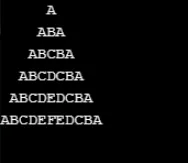
Conclusão
então acima estão alguns exemplos de vários tipos de padrões. Podemos imprimir qualquer tipo de padrão com algumas alterações nos loops.
Artigos recomendados
Este é um guia para padrões em c #. Aqui discutimos a introdução e os três principais tipos de padrões em C #, juntamente com seus exemplos e implementação de código. Você também pode consultar os seguintes artigos para saber mais:
- O que é Design Pattern em C #?
- Perguntas sobre entrevista de padrão de design em C #
- Matrizes 2D em C #
- Substituindo em C #
- Substituindo em Java
- 3 tipos diferentes de matrizes em PHP (exemplos)
- Padrões numéricos em Java com exemplos